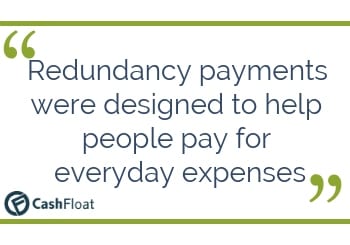Have you lost your job and wondering if their is any payment help available? You have come to the right place. Cashfloat explains in ‘Lost your Job’ guide all about the Statutory Redundancy Payments.
Lost Your Job? What Can You Do? – Chapter Three

If you are made redundant, your employer by law must pay Statutory Redundancy Payments. This is a minimum amount that your employer will give you as a financial safety net. This should prevent you from having to take out unsecured short term loans and falling into debt. Discover how much your statutory redundancy pay is with Cashfloat’s guide to job loss.
The History of Redundancy Payments
Before the Redundancy Payments Act of 1965, people who lost their jobs did not receive any statutory severance pay. The government introduced the Act as a safety net. After a qualifying period at work, but lost your job through no fault of your own, you would have a right to payment. The law designed it to help people pay for everyday expenses.
The act makes it a regulation for employers to provide ex-employees with a minimum amount of money to survive unemployment. It allows the employee to have a financial safety net to fall back if they didn’t find work straight away. Additionally, it would make employers think more carefully before making workers redundant.
There are three parts of employment law that forms the pillar of worker’s rights in the UK. They are:
- The Contracts Of Employments Act
- The Industrial Relations Act
- The Redundancy Payments Act


Statutory Redundancy Payment
If your employer advises you that your job is disappearing for one reason or another, it entitled you to some compensation. Provided that you have worked in the company for a minimum of two years, you can receive this compensation.
Statutory Redundancy Pay is the amount that is set down by law. You cannot receive payments less than the set amount. They are subject to change when the government introduces the annual financial budget. If you are working for a company as a contractor or a self-employed worker, then no statutory redundancy pay is applicable.
Most people who work for legitimate companies class as employees. However, there are some exceptions. Short term casual workers, self-employed, and agency workers regarding redundancy payments often also class as employees. However, an agency worker who is on a fixed term contract that is running for more than two years may class as an employee. Additonally, if the agency worker has continuous operating contracts, totalling up to more than two years, may also be considered for redundancy pay.
Certain occupations such as police officers and civil servants do not get statutory redundancy payments. But, they will get contractual redundancy pay. A check of the contract of employment will advise you about your rights to these payments.
How is Statutory Redundancy Pay Calculated?
In some circumstances, you may not be entitled to statutory redundancy payments. Any employer who offers an alternative job that is suitable to your skills may lawfully retract statutory redundancy pay if you refuse the job offer. If you find a replacement job before your period of notice expires, it is possible to lose the statutory amount. However, in some cases, you still receive it.
Depending on your age, length of service and how much you earn, the amounts of statutory redundancy pay are set at certain levels:
- An employee below the age of 22 is entitled to half a week’s pay for each complete year of employment.
- Employees aged 22 to 40 will get a full week’s pay for each year of service.
Those over the age of 41 will receive a week and half of pay for each year that they have worked at the company. However, the government cap statutory redundancy pay at 20 years of service. There is also a weekly payment limit. This stipend currently stands at £525 per week* and the maximum statutory redundancy pay you can get is £15,750*. The figures use gross pay, not net pay.

How Commission, Bonuses And Overtime Payments are Worked Out
If your work hours varied each week or month, then your payment will be based upon an average weekly pay. This payment will include commission payments or bonuses. However, it does not include some commission payments. It does include commission payments that use a definite factor, i.e. the number of letters that you write each week.
Payments do not include a commission based upon how successful you are at your job. For example, the number of insurance policies that you sell. The amount of commission due is worked out as an average over the 12 weeks before you got notice of redundancy. Unless your contract of employment includes overtime, it does not form part of the calculation for statutory redundancy payments.


What to do if your Employer Refuses to Pay Statutory Redundancy Payments
You can challenge failure by an employer, for any reason, to make a statutory redundancy payment. First, ask your employer for a written statement about why they have not paid you. You must ask for this within six months of leaving. If there is still no response to your request, then you can go to an Employment Tribunal and make a claim. The time limit for making a claim is three months from your dismissal. This applies whether you consider yourself unfairly dismissed or wish to claim discrimination.
The Redundancy Payments Act has been instrumental in preventing employers from hiring and firing employees at will. However, following the implementation of Brexit, employments laws that are mandatory for European Union countries could change.
Statutory Redundancy Pay FAQs
Is statutory redundancy pay taxable?
Statutory Redundancy payments do not attract the deduction of Income Tax. However, if the amount is over £30,000, there may be some tax to pay.
How should I claim statutory redundancy pay?
You do not need to claim Statutory Redundancy Payments. They are a right. Your employer is responsible for making the payment on the day you leave your job or very shortly after that. You are also entitled to a written statement confirming the amount and the method of calculation.
Where can I calculate my redundancy pay?
On gov.uk, you can calculate your redundancy pay using the statutory redundancy pay calculator. The calculation is based on age, weekly pay and the number of years in the job. You must have worked for at least 2 years at your employer in order to qualify.
If I changed from working full time to only part time a few weeks before being made redundant, how is the pay worked out?
Unfortunately, if you changed from full time to part time working hours before becoming redundant, then you receive the statutory amount for part time hours. Payments are calculated by what you earned at the time of redundancy.
Conclusion
Getting your statutory redundancy pay after being made redundant is often a life saver. Therefore, it is crucial you understand how the pay is worked out and know about any other benefits you may qualify for. Nobody should have to turn to payday loans online for finance when they have lost their jobs. For more information and help when you have lost your job, read more chapters in our guide.


*Correct as of October 2019.


